
Sumac, also spelled sumach, is any of about 35 species of flowering plants in the genus Rhus and related genera in the cashew family (Anacardiaceae). Sumacs grow in subtropical and temperate regions throughout every continent except Antarctica and South America. Sumac is used as a spice, as a dye, and in medicine.
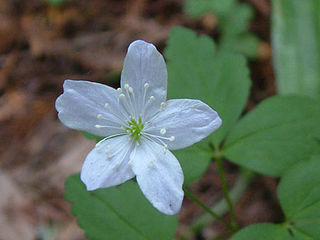
Anemonoides quinquefolia, a flowering plant in the buttercup family Ranunculaceae, is native to North America. It is commonly called wood anemone or windflower, not to be confused with Anemonoides nemorosa, a closely related European species also known by these common names. The specific epithet quinquefolia means "five-leaved", which is a misnomer since each leaf has just three leaflets. A plant typically has a single, small white flower with 5 sepals.

Searsia pyroides, previously known as Rhus pyroides, is a species of Searsia, native to southern Africa. This tree occurs throughout the whole of South Africa, a part of Botswana, Zimbabwe and Tanzania and in some areas of Namibia near Windhoek.

Searsia lancea commonly known as karee, is an evergreen, frost hardy, drought resistant tree, which can reach up to 8 metres in height with a 5-metre spread. It is one of the most common trees on the Highveld and in the Bushveld in South Africa, but not found in the Lowveld. In North America, where it is naturalized, it is known as African sumac and willow rhus.
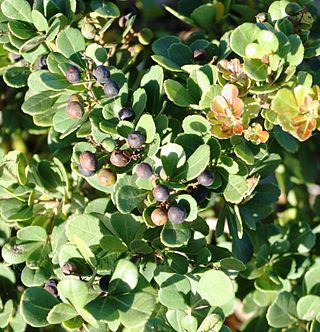
Searsia crenata, previously known as Rhus crenata,, is a species of Searsia that is native to South Africa, where it grows in frost-free and light frost areas, especially on beach sand dunes.
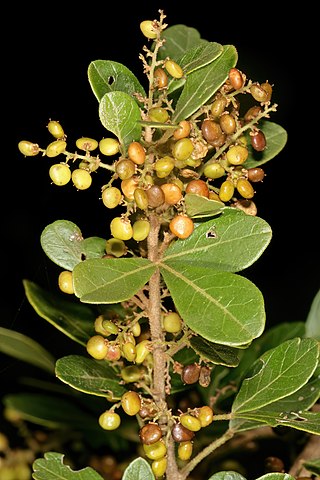
Searsia pentheri, the common crowberry (English), gewone kraaibessie (Afrikaans), iNhlokoshiyane (Zulu), or mutasiri (Venda), is a species of tree in the genus Searsia. Frost hardy tree reaching a height of up to 6 metres. The tree is mainly evergreen but loses its leaves in severe winters. It has olive-green foliage with dark brown bark and can be grown in either full sun or semi shade. Small flowers are produced and are followed by masses of shiny, light brown, small edible fruits, which provide a feast for birds. Only female trees produce these fruits though. The tree occurs over large portions of South Africa. It has been planted in Spain.

Echinacea simulata, commonly called wavy leaf purple coneflower, glade coneflower, or prairie purple coneflower, is a species of perennial flowering plant in the family Asteraceae. It is native to the east-central states of the United States. Its natural habitat is dry, calcareous, open areas such as barrens and woodlands.
This page provides a glossary of plant morphology. Botanists and other biologists who study plant morphology use a number of different terms to classify and identify plant organs and parts that can be observed using no more than a handheld magnifying lens. This page provides help in understanding the numerous other pages describing plants by their various taxa. The accompanying page—Plant morphology—provides an overview of the science of the external form of plants. There is also an alphabetical list: Glossary of botanical terms. In contrast, this page deals with botanical terms in a systematic manner, with some illustrations, and organized by plant anatomy and function in plant physiology.

Hydrocotyle vulgaris, the marsh pennywort, common pennywort, water naval, money plant, lucky plant or copper coin, is a small creeping aquatic perennial plant native to North Africa, Europe, the Caucasus and parts of the Levant.

Arytera divaricata, known as the gap axe, coogara, coogera or rose tamarind is a forest tree of eastern Australia. An attractive plant with glossy pale and limp new leaves. It grows in fairly dry situations, often in littoral rainforests and monsoon forest.
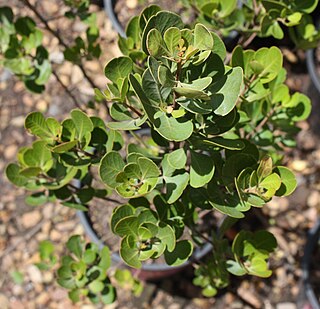
Searsia glauca is a small, compact tree or bush native to the Cape Provinces of South Africa. Although commonest near the coast, it is also found inland among fynbos vegetation.
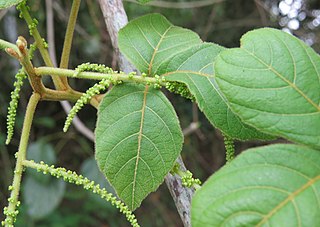
Allophylus cobbe, commonly known as titberry or Indian allophylus, is a pantropical, shrub in the family Sapindaceae with many uses in traditional medicine. It has a highly variable morphology throughout its range and may prove to be more than one species.

Rhus kearneyi is a species of flowering plant in the cashew family known by the common name Kearney's sumac. It is native to western North America, where it can be found in Arizona in the United States and Baja California in Mexico.

Searsia chirindensis is a medium-sized, semi-deciduous, trifoliate Southern African dioecious tree of up to 10 m tall, rarely 20 m, often multi-stemmed, occurring along the coastal belt from the Cape, through KwaZulu/Natal, Eswatini, Zimbabwe and Mozambique as far north as Tanzania, and growing in a wide variety of habitats such as open woodlands, in forests, along forest margins, in the open, among rocks and on mountain slopes. It was named by Swynnerton from a specimen collected by him near the Chirinda Forest in the Chipinge District of Southern Rhodesia. This is one of more than a hundred southern African species in the genus. It is commonly known as red currant because of a fancied resemblance of the fruit to that of the European redcurrant.
Branches dull brown or blackish, cylindric, pubescent or glabrous. Petiole 1·5–6·5 cm. long, almost cylindric, narrowly canaliculate and marginate above, pubescent or glabrous. Leaflets ± dull red-brown, ovate or ovate-lanceolate, acuminate, entire and ± undulate at the margin, membranous to ± rigid or subcoriaceous, glabrous or ± pubescent on the margin, midrib and nerves; median leaflet (3)6–13(16) × (1·2)2·5–4(7) cm., cuneate and frequently petiolulate at the base, the lateral ones (2)2·5–7(12) × (0·8)1·3–3·5(5·5) cm., asymmetric and slightly cuneate or somewhat rounded at the base, very shortly petiolulate to sessile; midrib slightly raised in the upper surface, very prominent below; lateral nerves arcuate, slender, raised on both sides, reticulation lax, almost invisible or sometimes conspicuous. Panicles terminal and axillary, ample, pyramidal, much branched, multiflorous, the terminal ones longer than the leaves, the axillary ones as long as the latter or somewhat longer; pedicels 1–2·5 mm. long. Male flowers: calyx-segments 0·5 mm. long, ovate, obtuse, glabrous; petals c. 1·5 mm. long, elliptic, obtuse; filaments c. 1 mm. long. Female flowers: ovary ovoid; styles reflexed; disk cupuliform, 5-lobulate; staminodes present. Drupe pinkish-yellow to reddish-brown, shining, (4)5(6) mm. in diam., globose, glabrous.

Searsia batophylla, the bramble currant, is a localized shrub that is endemic to the vicinities of Steelpoort and Burgersfort in Sekhukhuneland, Limpopo, South Africa. It is an evergreen, drought resistant plant that grows in the rain shadow of the Limpopo Drakensberg. Its natural range has been impacted by mining, human settlements and overgrazing. Though locally common in 26 sub-populations, it is estimated that they have been reduced to some 30% of their former population and range due to these human activities.

Allophylus decipiens (E.Mey.) Radlk., commonly known as the bastard taaibos, is a multi- or single-stemmed, small, evergreen tree about 3–4 m in height occurring in coastal forest, fringe forest and thickets, and wooded ravines and streams. Found up to 800 m in the southern coastal regions of the Cape Province, KwaZulu-Natal, Eswatini, along the escarpment forest of Mpumalanga, including Soutpansberg and in Mozambique. There are some 219 species in the genus of Allophylus.
Salix daltoniana is a shrub or small tree from the genus of the willow with mostly 4.5 to 9 centimeters long leaf blades. The natural range of the species is in India, Nepal, Bhutan, and in Tibet.
Salix divergentistyla is a shrub or tree from the genus of willow (Salix) with mostly 3 to 4.5 centimeters long leaf blades. The natural range of the species is in Tibet.
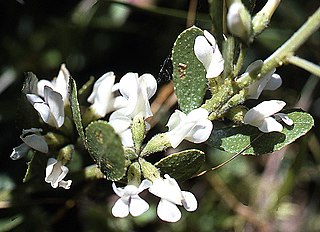
Otholobium lucens is a shrub of up to 60 cm (24 in) high that is assigned to the pea family. It has alternately set clover-like leaves crowding on the new growth, while older parts have lost their leaves. The white, pea-like flowers occur with 3 or 6 together in the leaf axils. This rare species is an endemic of the Swartberg mountains in the Western Cape province of South Africa. It flowers between July and February.

















